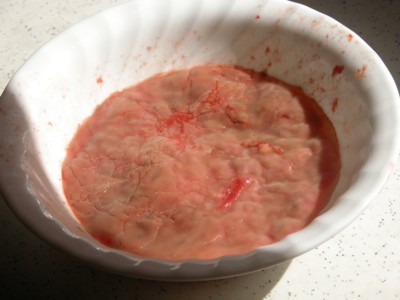
Saving Tomato and Pepper Seeds
 The last of the easy seeds we save are
tomatoes and peppers. I've combined them into this post even
though they have different seed-saving techniques since they're in the
same family. If you've been reading along daily, these guys are
just a repeat of the methods we've been discussing all week.
The last of the easy seeds we save are
tomatoes and peppers. I've combined them into this post even
though they have different seed-saving techniques since they're in the
same family. If you've been reading along daily, these guys are
just a repeat of the methods we've been discussing all week.
Pepper seeds are a lot like squash seeds --- easy to save as long as
you keep hybridization in mind. Many hot peppers are in the same
species as your bell peppers, so don't grow them close together or you
may be surprised by the zest of next year's "sweet" peppers!
However, peppers don't hybridize quite as readily as cucurbits, so
you'll probably be okay saving two different varieties from the same
garden as long as they're separated by at least 50 feet. To save
pepper seeds, allow the peppers to ripen completely (to yellow, orange,
or red, depending on the variety). Then cut out the core, brush
off the seeds, dry the seeds in the open for a while, and put them in
your seed box. Just keep in mind that the hottest part of hot
peppers is the seeds, and you won't be thrilled if you touch your face
after handling hot pepper guts.
 Although some sources say differently, in
my experience heirloom tomatoes don't cross-pollinate. I've had
good luck saving seeds from different types of tomatoes growing next
door to each other, and I suspect you will too. To save tomato
seeds, pick ripe tomatoes, squeeze out the guts into a jar, add a bit
of water, and ferment the seeds for a few days just like you did the
cucumber seeds. Then pour off the liquid and film of fungus,
rinse the seeds, dry them, and save them.
Although some sources say differently, in
my experience heirloom tomatoes don't cross-pollinate. I've had
good luck saving seeds from different types of tomatoes growing next
door to each other, and I suspect you will too. To save tomato
seeds, pick ripe tomatoes, squeeze out the guts into a jar, add a bit
of water, and ferment the seeds for a few days just like you did the
cucumber seeds. Then pour off the liquid and film of fungus,
rinse the seeds, dry them, and save them.
I'd be curious to hear if anyone out there has reached beyond the basic
seed-saving level we've attained. What would be the next
vegetable on your list to save after the ones mentioned in this series?
| This post is part of our Seed Saving lunchtime series.
Read all of the entries: |
Want more in-depth information? Browse through our books.
Or explore more posts by date or by subject.
About us: Anna Hess and Mark Hamilton spent over a decade living self-sufficiently in the mountains of Virginia before moving north to start over from scratch in the foothills of Ohio. They've experimented with permaculture, no-till gardening, trailersteading, home-based microbusinesses and much more, writing about their adventures in both blogs and books.
Want to be notified when new comments are posted on this page? Click on the RSS button after you add a comment to subscribe to the comment feed, or simply check the box beside "email replies to me" while writing your comment.
